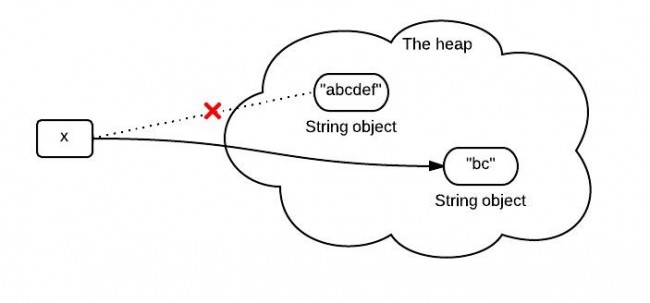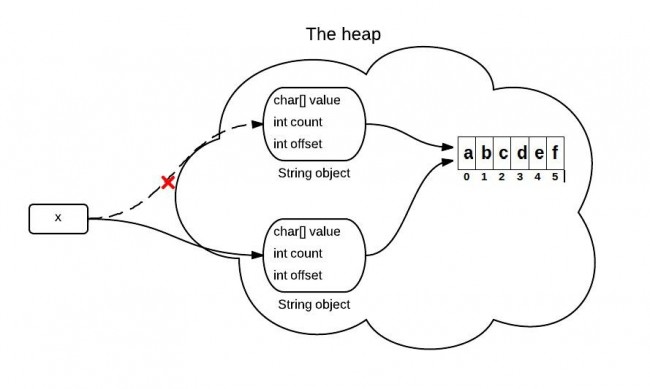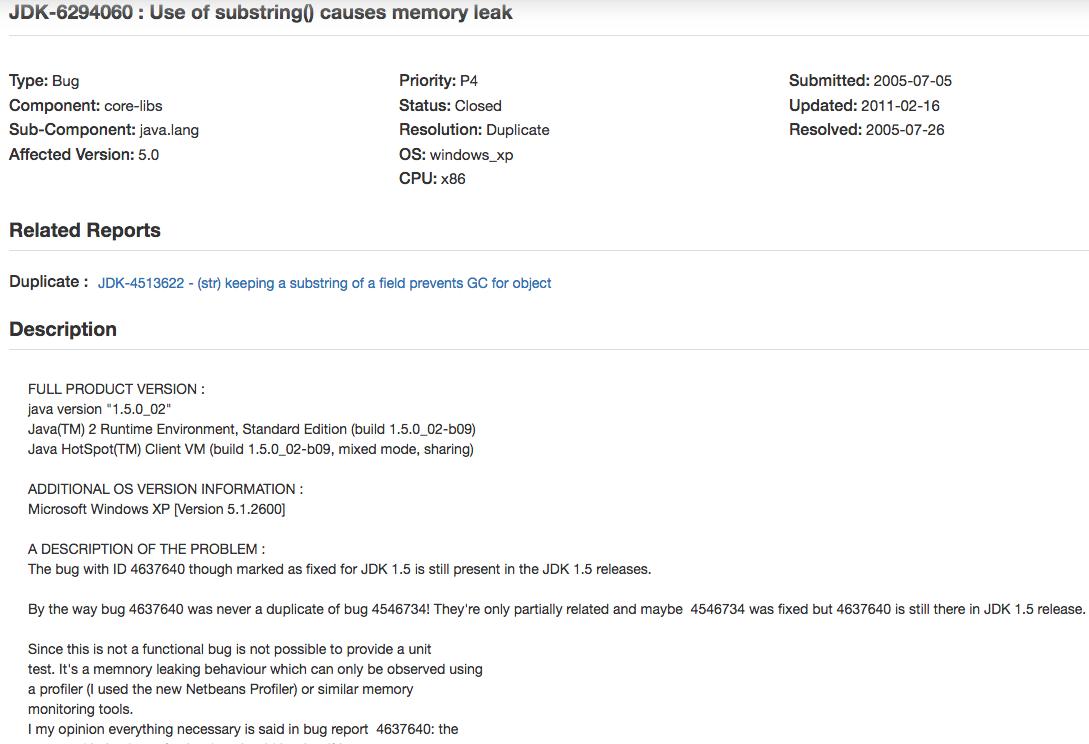substring实现原理
String是Java中一个比较基础的类,每一个开发人员都会经常接触到。而且,String也是面试中经常会考的知识点。String有很多方法,有些方法比较常用,有些方法不太常用。今天要介绍的subString就是一个比较常用的方法,而且围绕subString也有很多面试题。
substring(int beginIndex, int endIndex)方法在不同版本的JDK中的实现是不同的。了解他们的区别可以帮助你更好的使用他。为简单起见,后文中用substring()代表substring(int beginIndex, int endIndex)方法。
substring()的作用
substring(int beginIndex, int endIndex)方法截取字符串并返回其[beginIndex,endIndex-1]范围内的内容。s
String x = "abcdef";
x = x.substring(1,3);
System.out.println(x);
输出内容:
bc
调用substring时发生了什么?
你可能知道,因为x是不可变的,当使用x.substring(1,3)对x赋值的时候,它会指向一个全新的字符串:

然而,这个图不是完全正确的表示堆中发生的事情。因为在jdk6 和 jdk7中调用substring时发生的事情并不一样。
JDK 6中的subString
tring是通过字符数组实现的。在jdk 6 中,String类包含三个成员变量:char value[], int offset,int count,他们分别用来:存储真正的字符数组、存储数组的第一个位置索引、存储字符串中包含的字符个数。
当调用substring方法的时候,会创建一个新的string对象,但是这个string的值仍然指向堆中的同一个字符数组。这两个对象中只有count和offset 的值是不同的。

源码
//JDK 6
String(int offset, int count, char value[]) {
this.value = value;
this.offset = offset;
this.count = count;
}
public String substring(int beginIndex, int endIndex) {
//check boundary
return new String(offset + beginIndex, endIndex - beginIndex, value);
}
存在的问题
如果有一个很长的字符串,但是你只需要使用很短的一段,于是你使用substring进行切割,但是由于你实际上引用了整个字符串,这个很长的字符串无法被回收。往小了说,造成了存储空间的浪费,往大了说,可能造成内存泄漏。这个问题已经被官方记录在Java Bug Database里面了:

相应的解决办法:
s1 = s1.substring(x,y) + "";
JDK 7 中的substring
上述问题在JDK 7中得到了解决。JDK 7中,substring方法会在堆中创建一个新的数组。

源码
//JDK 7
/**
* Allocates a new {@code String} that contains characters from a subarray
* of the character array argument. The {@code offset} argument is the
* index of the first character of the subarray and the {@code count}
* argument specifies the length of the subarray. The contents of the
* subarray are copied; subsequent modification of the character array does
* not affect the newly created string.
*
* @param value Array that is the source of characters
* @param offset The initial offset
* @param count The length
* @throws IndexOutOfBoundsException If the {@code offset} and {@code count} arguments index
* characters outside the bounds of the {@code value} array
*/
public String(char value[], int offset, int count) {
//check boundary
this.value = Arrays.copyOfRange(value, offset, offset + count);
}
/**
* Returns a string that is a substring of this string. The
* substring begins at the specified {@code beginIndex} and
* extends to the character at index {@code endIndex - 1}.
* Thus the length of the substring is {@code endIndex-beginIndex}.
* <p>
* Examples:
* <blockquote><pre>
* "hamburger".substring(4, 8) returns "urge"
* "smiles".substring(1, 5) returns "mile"
* </pre></blockquote>
*
* @param beginIndex the beginning index, inclusive.
* @param endIndex the ending index, exclusive.
* @return the specified substring.
* @throws IndexOutOfBoundsException if the
* {@code beginIndex} is negative, or
* {@code endIndex} is larger than the length of
* this {@code String} object, or
* {@code beginIndex} is larger than
* {@code endIndex}.
*/
public String substring(int beginIndex, int endIndex) {
//check boundary
int subLen = endIndex - beginIndex;
return ((beginIndex == 0) && (endIndex == value.length)) ?
this :
new String(value, beginIndex, subLen);
}
参考文献地址:https://hollischuang.github.io/toBeTopJavaer/#/basics/java-basic/substrin